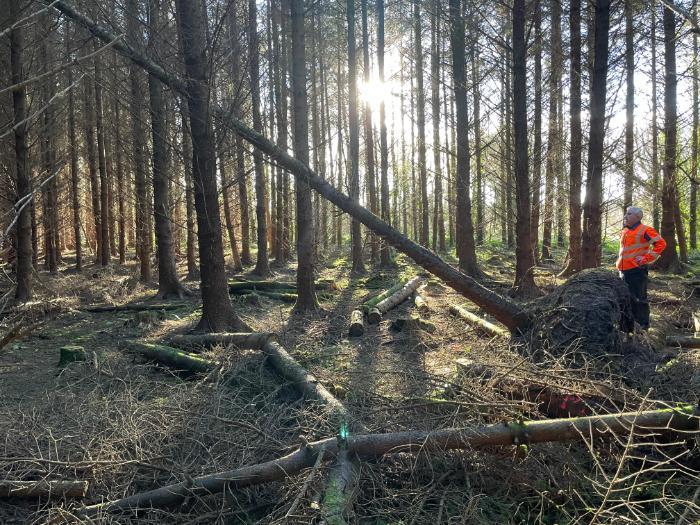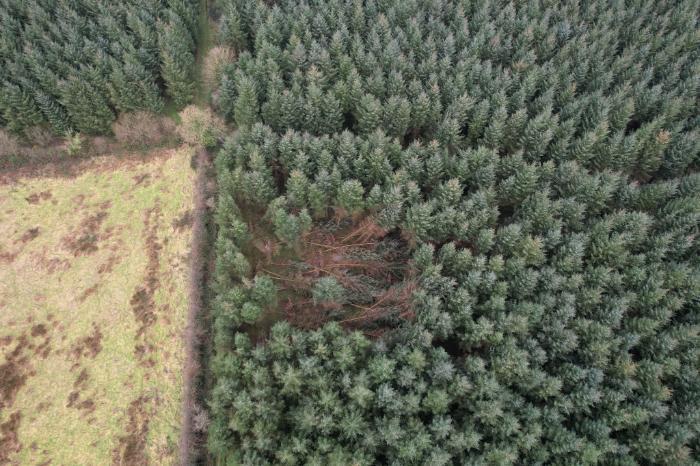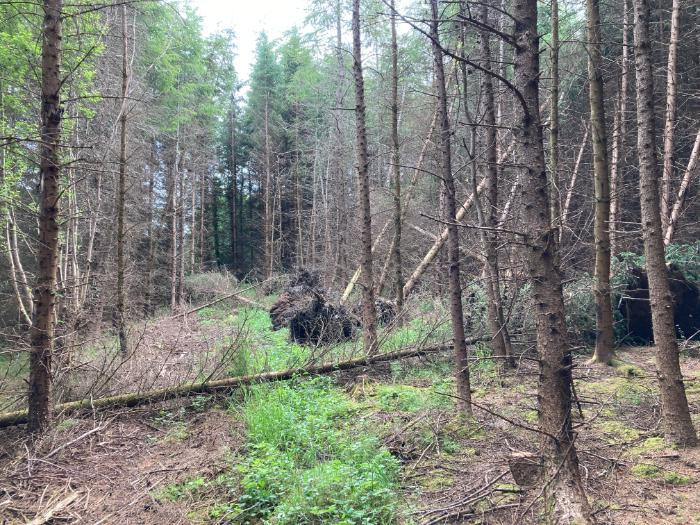24 January 2025
Managing Storm Damage in Your Forest: Practical Steps for Farmers

With a clear plan, professional advice, and careful management, farmers and other forest owners can effectively address storm damage, safeguard their forests, and recover as much value as possible. Tom Houlihan and John Casey tell us more.
If you have experienced storm damage in your forest, don’t rush into decisions, but instead, put together a step-by-step plan. This will allow you to minimise risks while maximising residual timber value following storm impacts. Tom Houlihan and John Casey, Teagasc Forestry Development Department, have advice on what you can do.
Wind events, such as the recent Storm Darragh, can cause varying degrees of damage around the country, including damage to forests. Most forests, despite storm impacts, can still have considerable timber value.
Step 1: Prioritise Safety First
Farmer and forest owners are urged to exercise extreme care, and stay safe, indoors, during any storm event. Post-event, a storm-damaged forest can be a hazardous place and safety should still be prioritised. Fallen and windblown trees are particularly risky to handle, especially near roads or power lines. Only fully trained and accredited professionals should undertake this work.
Make safety your top priority and follow the Health and Safety Authority’s guidelines. Remember, as a forest owner, you also have legal responsibilities.
Step 2: Check Your Insurance
If your forest is insured, especially for windblow, contact your insurance provider right away. They’ll arrange for an assessor to evaluate the damage. While insurance premiums may have risen post-Brexit, comprehensive forest insurance remains a wise investment for Irish farmers.
Step 3: Seek Professional Advice
Don’t go it alone. Reach out to your local forestry adviser, consultant, or taxation expert for tailored guidance. Independent advice can make all the difference in safeguarding your forest’s future.
Step 4: Assess the Damage
It’s crucial to get a clear picture of the storm’s impact:
- Survey the area: Identify the extent of the windblow, keeping safety in mind.
- Evaluate timber volume and value: Understand what can still be salvaged.
- Inspect the surrounding trees: Stability checks are essential for partially affected forests. If adjacent trees are deemed unstable, they’ll need to be included in your felling licence application.

Photo credit: Peter Farrelly
Step 5: Apply for a Felling Licence
A Felling Licence will be required to harvest the windblown timber and potentially any adjacent trees that may be at risk of windblow. If there is an existing thinning licence in place, you need to specify the licence number in your new felling licence application along with harvest and replanting plans. This will allow the DAFM to cancel the existing licence as the same land cannot have two licences. You can access further information at the following link: Felling of trees – legal requirements
Apply as soon as possible to allow time for processing of your felling licence application, as appropriate. Ash forests owners who have applied for and received approval for tree clearance under the DAFM Reconstitution Ash Dieback Scheme are not required to have a felling licence. Please also see: Legal requirements – ash dieback.
Step 6: Plan Access and Apply for Grants
Accessing the affected area is key to efficient recovery. Check if you qualify for a Forest Roads Scheme 2023-2027 grant from the Department of Agriculture, Food and the Marine (DAFM). Your forestry consultant can help you apply for this grant alongside your felling licence application.
Step 7: Selling Timber – Get the Best Deal
When selling timber, shop around. Seek multiple quotes from buyers and ensure you have a proper timber sales contract to protect your interests. This should cover the following:
- Agreed prices
- Harvesting procedures
- Insurance
- Environmental and safety compliance
Keep tight control over timber movement to ensure security and accountability. For further details, please see Teagasc’s Timber Harvesting and Sales Checklist

Step 8: Keep Records and Monitor the Process
Accurate record-keeping is essential for:
- Accounting and tax purposes
- Compliance with safety and environmental regulations
Supervise the harvesting and sale to ensure everything runs smoothly and aligns with your best interests.
Stay Informed and Supported
For further information, contact your local Teagasc Forestry Adviser or local Teagasc Office.
The Teagasc Forestry Department issues an article on a Forestry topic every Friday here on Teagasc Daily Subscribe to: Forestry e-News Keep up-to-date with the Teagasc Forestry Department here or follow them on Social Media here
